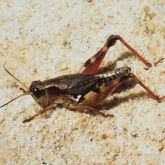Grasshoppers

Wingless grasshopper adult
© State of Western Australia (Department of Primary Industries and Regional Development, WA)

Grasshopper feeding on young western white gum (Eucalyptus argophloia) stem
© Department of Agriculture and Fisheries
Although they look similar, grasshoppers and locusts behave differently. Australian locusts often form into groups when nymph populations are dense, resulting in large-scale migrations from breeding areas. Grasshoppers generally remain solitary and localised.
Australia has about 500 native grasshopper species, some of which develop large, localised infestations. These species include:
- Phaulacridium vittatum (wingless grasshopper)
- Valanga irregularis (giant grasshopper)
- Other genera include Lagoonia, Novum, Peakesia, Stropis and Yrrhapta
In Queensland, the wingless grasshopper is the most common grasshopper species to cause damage in field crops and pastures.
Scientific name
Description
- Large hindlegs modified for jumping
- Forewings (if present) are toughened
- Nymphs are a similar shape to the adults
- Females are about 18–20mm long; males are smaller.
- Body colour and patterns are highly variable.
- In low density populations, they may have 2 white stripes along their back.
- The hind leg is usually orange with a black mark in the middle of the 'thigh'.
- Nearly two-thirds of adults have short ineffective wings; the rest develop longer wings and can fly.
May be confused with
Wingless grasshoppers may be confused with nymphs of other grasshopper and locust species.
Distribution and habitat
Grasshoppers are widely distributed across Australia. Wingless grasshoppers prefer temperate areas with annual rainfall more than 500mm.
Hosts
A wide range of native and introduced herbaceous broadleaf plants, including pasture and weed species and some native tree species.
Preferred plantation tree species include spotted gum (Corymbia citriodora subsp. variegata), Corymbia hybrids, western white gum (Eucalyptus argophloia) and grey gum (E. longirostrata).
Damage
Wingless grasshoppers damage crops,pastures and young plantations by chewing leaves and stems.
Most damage by wingless grasshoppers to pastures occurs in mid-summer and autumn, following moderately dry years. Preferential feeding on the legume component of improved pastures can damage newly established areas so severely that re-sowing is necessary.
Wingless grasshopper impacts on saplings and young plantations include defoliation, stem damage, branch dieback and loss of form. Damage is more prevalent during drought where trees provide an alternative source of moist foliage and bark for grasshopper feeding.
Life cycle
Wingless grasshoppers
- Tear-shaped egg pods containing about 12 eggs are laid into the soil.
- Eggs diapause during winter and hatch in mid to late spring.
- Nymphs develop through 5 instars and become adults in mid-December to early January.
Monitoring and thresholds
- Monitor for groups of nymphs and take action at first evidence of aggregating.
- Treatment of low-value pastures is not usually cost-effective.
Natural enemies
- Up to 30% of eggs may be parasitised by Scelio spp., and there are several dipteran (fly) parasitoids of nymphs and adults.
- Nematodes are important regulators of wingless grasshopper populations in New South Wales, but are highly dependent on rainfall for successful parasitism.
- Birds (e.g. crows, magpies and ibis) prey on wingless grasshoppers, and guinea fowl may be a useful predator in gardens.
- Cannibalistic feeding in wingless grasshopper adults may transmit a natural amoebic disease (caused by Malmeba locustae).
Control
Insecticide
- Use ground-sprays (not aerial) to protect valuable pastures and irrigated fodder crops, particularly when stock feed is limited.
- Control infestations near crops with barrier treatments (spraying or baiting).
- Baits of wheat bran mixed with insecticide are most effective when applied to bare ground.
- Several applications of baits or sprays may be necessary in a single season.
Cultural control
- Maintaining a dense, grassy pasture without bare areas (where grasshoppers can lay eggs) can help keep numbers in check.
- Effective weed control may help reduce the intensity of outbreaks.
- Ensure pastures in areas that have had wingless grasshopper outbreaks have a high component of grass species.
Biological control
- A biopesticide containing spores of the fungus Metarhizium anisopliae is available commercially in Australia.
Further information
- Locusts
- Wingless grasshoppers and their control - Department of Primary industries and Regional Development Western Australia
- Wingless grasshoppers - Department of Primary Industries New South Wales
- Registered chemicals database - Australian Pesticides and Veterinary Medicines Authority (APVMA)
- Last reviewed: 22 Nov 2019
- Last updated: 28 Sep 2023